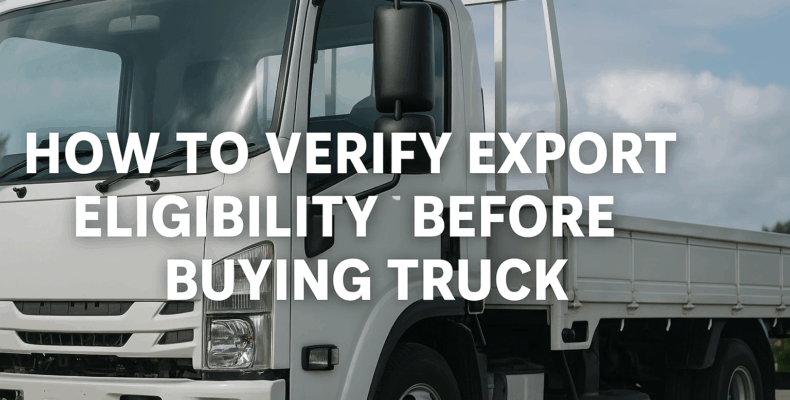Buying a Japanese used truck for international use is a smart move. However, before you close the deal, you must confirm one critical detail: Is the truck eligible for export from Japan?
Not all vehicles in Japan meet export requirements. Some may have title issues, unpaid taxes, or even registration restrictions. Without proper verification, you could waste money—or worse, face customs rejection.
Luckily, checking a truck’s export eligibility is easy once you know what to look for.
🚛 Why Export Eligibility Matters
Every country has its own rules for importing vehicles. At the same time, Japan has regulations that determine whether a used truck can leave the country legally. If your truck doesn’t meet export criteria, shipping may be delayed or denied.
Moreover, trucks with incomplete paperwork or missing inspections often lead to high costs and frustration for overseas buyers.
That’s why it’s important to verify export eligibility early—before paying or arranging transport.
✅ Checklist: How to Confirm Export Eligibility
Use this checklist when considering a Japanese used truck for export.
1. Check the Export Certificate (Registration Paper)
In Japan, this document is called the “KAIHATSU KEN” or “Shaken Certificate”.
-
It should include the VIN number, engine number, and vehicle category.
-
Check if the ownership history is clear.
-
Make sure there are no notes like “export prohibited” or “domestic use only.”
Also, the vehicle status must be marked as “ready for deregistration” or “export purpose.”
2. Verify Mileage and Condition Are Accurate
Trucks with rollback odometers or unknown service records can be flagged.
-
Check if the mileage is digitally verified through JEVIC or other systems.
-
Make sure the condition matches auction sheets or inspection reports.
-
Avoid trucks with serious accident history, flood damage, or frame rust.
Accurate condition helps avoid inspection issues at customs in your country.
3. Confirm Emission Standard Compliance
Every country has different emission rules. Make sure the truck meets your target country’s standard.
-
Use the Emission Code Plate near the driver’s seat.
-
Ask your exporter for confirmation of NOx/PM compliance or equivalent certification.
-
Some older trucks are not allowed in specific regions.
👉 For a detailed explanation, check our article on
Japanese Truck Emission Standards
4. Ensure Proper Deregistration Process
Before a truck is exported, it must be deregistered from Japan’s road system.
-
Ask your exporter to provide the Deregistration Certificate (抹消登録証明書).
-
This document proves the vehicle has been officially removed from domestic use.
-
Without it, shipping and customs clearance will be blocked.
Make sure your name (or your company’s) appears on the buyer section if pre-export transfer is involved.
5. Ask Your Exporter to Confirm Export Readiness
Reliable exporters handle this process professionally. They will:
-
Provide all legal documents in advance
-
Offer detailed photos and inspection reports
-
Advise if the truck is eligible for export based on your country’s import laws
We strongly recommend choosing trusted partners like those in the article below:
👉 Top 5 Trusted Japanese Used Truck Exporters for Global Buyers
These exporters have experience in global shipping and know which trucks can be exported without trouble.
🌐 Additional Tips for Global Buyers
-
Check import restrictions in your country before purchasing.
-
Use a shipping agent who has experience with Japanese imports.
-
Never pay in full before you confirm paperwork and export status.
-
Ask for copies of all documents before the vehicle leaves Japan.
📝 Final Thoughts
Before you invest in a Japanese used truck, make sure it can actually leave Japan and enter your country legally. While most trucks meet the criteria, some don’t—and the consequences can be expensive.
By following this simple checklist, you’ll avoid common export pitfalls and enjoy a smooth, stress-free buying experience.
When in doubt, work with experienced exporters who understand both Japanese legal requirements and international shipping standards. It’s the smartest way to protect your purchase.
